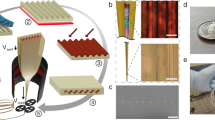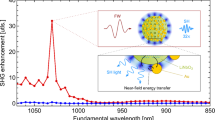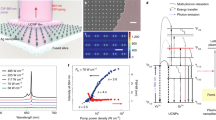Abstract
Conjugated polymers have chemically tuneable opto-electronic properties and are easily processed, making them attractive materials for photonics applications1,2. Conjugated polymer lasers, in a variety of resonator geometries such as microcavity3, micro-ring4, distributed feedback5 and photonic bandgap6 structures, have been fabricated using a range of coating and imprinting techniques. Currently, one-dimensional nanowires are emerging as promising candidates for integrated, subwavelength active and passive photonic devices7,8,9,10. We report the first observation of optically pumped lasing in single conjugated polymer nanowires. The waveguide and resonator properties of each wire are characterized in the far optical field at room temperature. The end faces of the nanowire are optically flat and the nanowire acts as a cylindrical optical cavity, exhibiting axial Fabry–Pérot mode structure in the emission spectrum. Above a threshold incident pump energy, the emission spectrum collapses to a single, sharp peak with an instrument-limited line width that is characteristic of single-mode excitonic laser action.
This is a preview of subscription content, access via your institution
Access options
Subscribe to this journal
Receive 12 print issues and online access
$259.00 per year
only $21.58 per issue
Buy this article
- Purchase on Springer Link
- Instant access to full article PDF
Prices may be subject to local taxes which are calculated during checkout




Similar content being viewed by others
References
Sirringhaus, H., Tessler, N. & Friend, R. H. Integrated optoelectronic devices based on conjugated polymers. Science 280, 1741–1744 (1998).
Carpi, F. & De Rossi, D. Colours from electroactive polymers: electrochromic, electroluminescent and laser devices based on organic materials. Opt. Laser Technol. 38, 292–305 (2006).
Tessler, N., Denton, G. J. & Friend, R. H. Lasing from conjugated-polymer microcavities. Nature 382, 695–697 (1996).
Frolov, S. V., Shkunov, M., Vardeny, Z. V. & Yoshino, K. Ring microlasers from conducting polymers. Phys. Rev. B 56, R4363–4366 (1997).
Heliotis, G. et al. Emission characteristics and performance comparison of polyfluorene lasers with one- and two-dimensional distributed feedback. Adv. Funct. Mater. 14, 91–97 (2004).
Riechel, S. et al. A nearly diffraction limited surface emitting conjugated polymer laser utilizing a two-dimensional photonic band structure. Appl. Phys. Lett. 77, 2310–2312 (2000).
Johnson, J. C. et al. J. Single gallium nitride nanowire lasers. Nature Mater. 1, 106–110 (2002).
Duan, X., Huang, Y., Agarwal, R. & Lieber, C. M. Single-nanowire electrically driven lasers. Nature 421, 241–245 (2003).
Law, M. et al. Nanoribbon waveguides for subwavelength photonics integration. Science 305, 1269–1273 (2004).
Tong, L. et al. Subwavelength-diameter silica wires for low-loss optical wave guiding. Nature 426, 816–819 (2003).
Xia, R., Heliotis, G., Hou, Y. & Bradley, D. D. C. Fluorene-based conjugated polymer optical gain media. Org. Electron. 4, 165–177 (2003).
Ariu, M. et al. The effect of morphology on the temperature-dependent photoluminescence quantum efficiency of the conjugated polymer poly(9,9-dioctylfluorene). J. Phys.: Condens. Matter 14, 9975–9986 (2002).
Rothe, C., Galbrecht, F., Scherf, U. & Monkman, A. The β-phase of poly(9,9-dioctylfluorene) as a potential system for electrically pumped organic lasing. Adv. Mater. 18, 2137–2140 (2006).
Babel, A., Li, D., Xia, Y. & Jenekhe, S. A. Electrospun nanofibers of blends of conjugated polymers: morphology, optical properties, and field-effect transistors. Macromolecules 38, 4705–4711 (2005).
Masuo, S. et al. Assembling and orientation of polyfluorenes in solution controlled by a focused near-infrared laser beam. J. Phys. Chem. B 109, 6917–6921 (2005).
Zhang, X., Zhang, J., Song, W. & Liu, Z. Controllable synthesis of conducting polypyrrole nanostructures. J. Phys. Chem. B 110, 1158–1165 (2006).
Steinhart, M. et al. Polymer nanotubes by wetting of ordered porous templates. Science 296, 1997 (2002).
Chen, S. H., Su, A. C., Su, C. H. & Chen, S. A. Crystalline forms and emission behavior of poly(9,9-di-n-octyl-2,7-fluorene). Macromolecules 38, 379–385 (2005).
Sims, M. et al. Understanding the origin of the 535 nm emission band in oxidized poly(9,9-dioctylfluorene): the essential role of inter-chain/inter-segment interactions. Adv. Funct. Mater. 14, 765–781 (2004).
Balzer, F., Bordo, V. G., Simonsen, A. C. & Rubahn, H.-G. Optical waveguiding in individual nanometer-scale organic fibers. Phys. Rev. B 67, 115408 (2003).
Campoy-Quiles, M. et al. Ellipsometric characterisation of the optical constants of polyfluorene gain media. Adv. Funct. Mater. 15, 925–933 (2005).
Johnson, J. C., Yan, H., Yang, P. & Saykally, R. J. Optical cavity effects in ZnO nanowire lasers and waveguides. J. Phys. Chem. B 107, 8816–8828 (2003).
Snyder, A. W. & Love, D. Optical Waveguide Theory (Kluwer Academic Publishers, Boston, 1983).
Hide, F., Schwartz, B. J., Díaz-García, M. A. & Heeger, A. J. Conjugated polymers as solid-state laser materials. Synth. Met. 91, 35–40 (1997).
Virgili, T. et al. An ultrafast spectroscopy study of stimulated emission in poly(9,9-dioctylfluorene) films and microcavities. Appl. Phys. Lett. 74, 2767–2769 (1999).
Baldo, M. A., Holmes, R. J. & Forrest, S. R. Prospects for electrically pumped organic lasers. Phys. Rev. B 66, 035321 (2002).
Acknowledgements
We thank D. Iacopino for assistance with SEM measurements. The support of the Irish HEA PRTLI Programme and IRCSET Embark Initiative as well as the European Union Sixth Framework Programme is gratefully acknowledged.
Author information
Authors and Affiliations
Corresponding author
Ethics declarations
Competing interests
The authors declare no competing financial interests.
Supplementary information
Supplementary Information
Supplementary figures S1—S4 (PDF 291 kb)
Rights and permissions
About this article
Cite this article
O'Carroll, D., Lieberwirth, I. & Redmond, G. Microcavity effects and optically pumped lasing in single conjugated polymer nanowires. Nature Nanotech 2, 180–184 (2007). https://doi.org/10.1038/nnano.2007.35
Received:
Accepted:
Published:
Issue Date:
DOI: https://doi.org/10.1038/nnano.2007.35
This article is cited by
-
Stable organic self-assembled microwire lasers for chemical vapor sensing
Communications Chemistry (2021)
-
Experimental study of optical properties of polymeric nanowires: exciton dynamic migration
Applied Physics A (2021)
-
Controllable Polarization of Lasing Emission From a Polymer Microfiber Laser
Scientific Reports (2019)
-
π-Conjugated polymer nanowires: advances and perspectives toward effective commercial implementation
Polymer Journal (2018)
-
Flexible integration of free-standing nanowires into silicon photonics
Nature Communications (2017)



